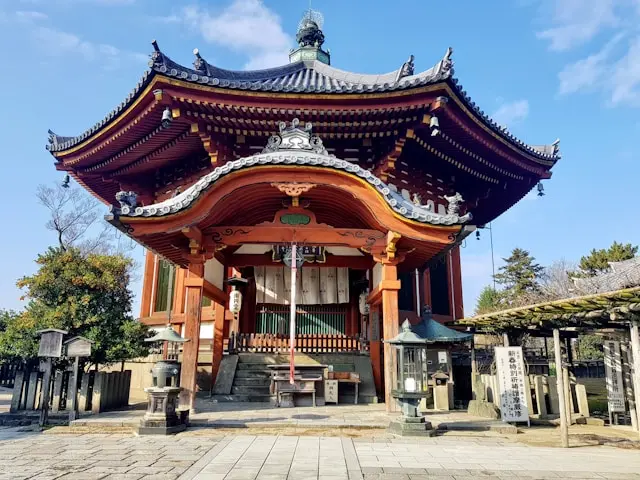
1. The Oldest Wooden Architectural Complex and Japan’s First UNESCO World Heritage Site: Horyu-ji Temple
Visiting Horyu-ji Temple in Nara feels like stepping into a time machine—it’s home to the oldest wooden architectural complex in Japan. The temple is divided into the Eastern and Western Precincts, with the Western Precinct housing treasures like the Golden Hall, Five-Story Pagoda, Central Gate, and cloister, all constructed from wood. These structures are designated as National Treasures and were inscribed as Japan’s first UNESCO World Cultural Heritage Site in 1993 under the name “Buddhist Monuments in the Horyu-ji Area.”
Horyu-ji is not only a significant Buddhist site but also a masterpiece of architectural craftsmanship, showcasing the advanced skills and wisdom of ancient builders. Tokyo’s iconic Skytree even drew inspiration from the structural design of Horyu-ji’s Five-Story Pagoda.
• Address: 1-1 Horyuji Sannai, Ikaruga-cho, Ikoma-gun, Nara Prefecture
• Hours:
• February 22–November 3: 8:00–17:00
• November 4–February 21: 8:00–16:30
• Access: 20-minute walk from JR Horyu-ji Station or take a bus to “Horyuji-mae.”
2. The Largest Wooden Structure: Todai-ji Temple
While Nara is home to the oldest wooden structures, it also houses Japan’s largest wooden building: Todai-ji Temple. With over 1,200 years of history, this iconic temple is famous for its 15-meter-tall Great Buddha statue. The Great Buddha Hall, measuring 57 meters wide and 50 meters deep, exudes grandeur and timeless beauty.
Inside the hall, in addition to the Great Buddha, the statues of the Heavenly Kings in the northeast and northwest corners leave a strong impression with their imposing presence. Behind the hall, a wooden pillar with a hole at its base is said to match the size of the Great Buddha’s nostrils. Legend has it that passing through the hole brings good fortune and health.
• Address: 406-1 Zoshicho, Nara City, Nara Prefecture
• Hours:
• April–October: 7:30–17:30
• November–March: 8:00–17:00
• Access: 20-minute walk from Kintetsu Nara Station or a 5-minute walk from the “Daibutsuden Kasuga Taisha-mae” bus stop.
3. The Oldest Buddha Statue: Asuka-dera Temple
When people think of Buddha statues in Japan, the “Great Buddha of Kamakura” or the “Great Buddha of Nara” often come to mind. However, Nara’s Asuka-dera Temple in Asuka Village houses the oldest Buddha statue in Japan: the “Asuka Great Buddha,” a seated bronze statue of Shakyamuni.
Though modest today, Asuka-dera was three times larger than Horyu-ji when it was built. Unfortunately, the temple was destroyed by a fire in 1196 and wasn’t fully restored until 1826. The Great Buddha, darkened by soot, faces the legendary birthplace of Prince Shotoku, Tachibana-dera Temple, as if eternally guarding the prince who championed Buddhism in Japan.
• Address: 682 Asuka, Asuka Village, Takaichi-gun, Nara Prefecture
• Hours: 9:00–16:00
• Access: 5-minute walk from the “Asuka Daibutsu-mae” bus stop on the Asuka Loop Bus.
4. The Largest Square-Shaped Burial Mound: Ishibutai Kofun
Japan’s history includes a period known as the “Kofun Era,” during which large burial mounds were constructed. Nara offers a chance to experience this culture, as many kofun remain in the region. Among them, the Ishibutai Kofun in Asuka Historical Park is Japan’s largest square-shaped burial mound, believed to be the tomb of Soga no Umako.
The kofun is composed of over 30 giant stones, weighing a total of 2,300 tons. Even by today’s standards, building such a structure would require incredible skill and effort.
• Address: 254 Shimasho, Asuka Village, Takaichi-gun, Nara Prefecture
• Hours: 8:30–17:00
• Access: Take a Nara Kotsu Bus to “Ishibutai” (limited service; check the schedule beforehand).
5. The Oldest Portrait Sculpture: Ganjin Statue at Toshodai-ji Temple
Among Nara’s many UNESCO World Heritage Sites, Toshodai-ji Temple stands out for housing the oldest portrait sculpture in Japan: the statue of Ganjin.
The story of Ganjin, a Chinese monk who journeyed to Japan to spread Buddhist precepts, is well-known. After five failed attempts to cross the sea, Ganjin finally succeeded on his sixth try, despite losing his eyesight. Toshodai-ji was built at the emperor’s order to honor him, and the statue depicts Ganjin with his eyes closed, reflecting his blindness. Photography is not allowed, but the statue’s profound presence leaves a lasting impression.
• Address: 13-46 Gojo-cho, Nara City, Nara Prefecture
• Hours: 8:30–17:00
• Access: 5-minute walk from Kintetsu Kashihara Line “Nishi-no-Kyo” Station.
These are just a few of Nara’s historic “firsts.” With over a millennium of cultural accumulation, Nara offers countless treasures to discover. On your next visit, embark on a cultural journey to explore Nara’s many “firsts” in Japan!
